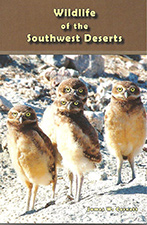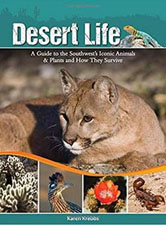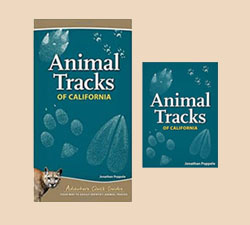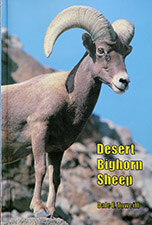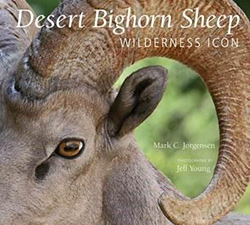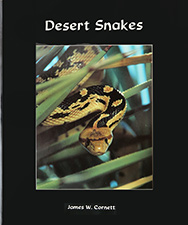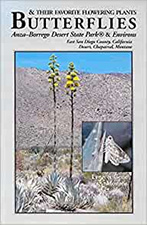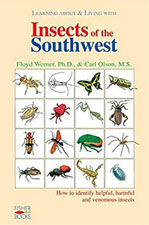
 |
 |
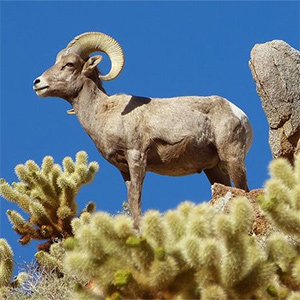 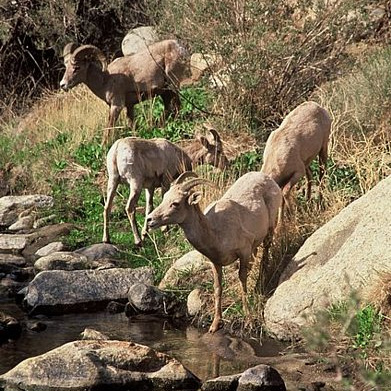 |
Big Horn Sheep Book Reference Desert Bighorn Sheep The peninsular bighorn sheep is at the top of the "want-to-see" list of many Anza-Borrego visitors. Listed as a federally endangered species in 1998, this species is found in several parts of Anza-Borrego and the Santa Rosa mountains to the north. Peninsular bighorns prefer dry and rocky low elevation areas, between 300 and 3500 feet in elevation. During the summer months desert bighorns are most likely to be seen near sources of water. Popular watering areas, such as those along Coyote Creek, are closed to vehicle traffic from June until October to allow the sheep access to water without disturbance. During the rest of the year, they may be spotted at various locations in Anza-Borrego Desert State Park. For the past 42 years, a count of Anza-Borrego's sheep has taken place over the fourth of July weekend, utilizing volunteers positioned at watering sites, to count the number of sheep coming to drink. It's a tough assignment, hiking in to a remote location in mid-summer with temperatures that can reach 115 degrees. But the annual sheep count plays an important role in monitoring the health of Anza-Borrego's bighorn population. An excellent place to look is along the Palm Canyon Trail, starting in the Borrego Palm Canyon Campground at the western edge of Borrego Springs. |
|
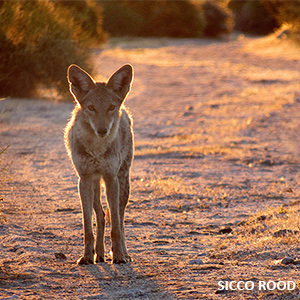 |
Other Critters | |
|
Book Reference
Wildlife of the Southwest Deserts Coyotes, Roadrunners, Black-Tailed Jackrabbits, Desert Cottontail Rabbits, Raccoons, and occassional sightings of Bobcats, are just some of the other creatures you may come across in Anza-Borrego Desert State Park and arround Borrego Springs. The nighttime yipping and yelping of coyotes is a common sound throughout Anza-Borrego and coyotes are frequently seen, both traversing the open desert and walking through residential areas. Coyotes are the ultimate survivors, found in virtually all environments and urban settings across North America. There is no one place to go, but the edges of golf courses, campgrounds, and anywhere else where you have some greenery meeting the desert are good places to stake out. In situations where they encounter humans on a regular basis they will loose their fear of humans and pay little attention. But dependence on humans is not something to be encouraged, and as fascinating as they may be, it is never a good idea to put food out for the coyotes. |
||
 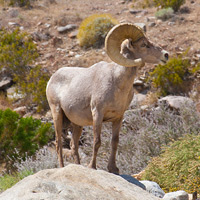 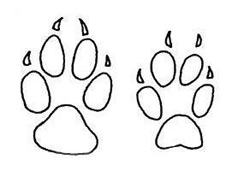 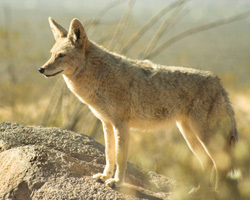 |
Animal Tracks Book Reference Animal Tracks of California There are many mammals, birds, and reptiles that live in the Anza-Borrego Desert. Some of these animals are moving around during the day, but many of them are nocturnal, venturing out only at night when temperatures are cooler and they are not as likely to be seen by preditors. With a little investigation you can discover what kinds of animals have passed through the desert. The streambed of Coyote Creek is a good place to look; you are certain to find tracks in the tracks in the mud along the streambanks. From Christmas Circle go east on Palm Canyon Drive (S22) for .5 miles and turn left (north) onto DiGiorgio Road and drive for 4.7 miles to the point where the pavement ends and a dirt road continues straight ahead into Coyote Canyon. This is one of the most heavily travelled dirt roads in the park and is normally in good condition for the first few miles. Drive or walk until you come to the first crossing of Coyote Creek. Along the streambed in Borrego Palm Canyon is another good place to look. |
|
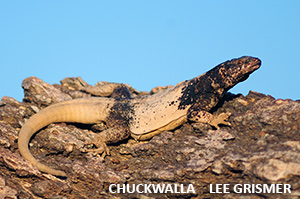 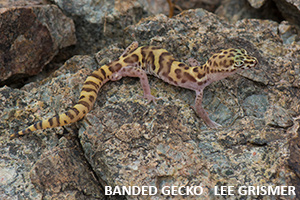 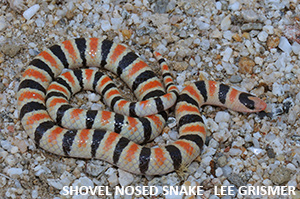 |
Reptiles | |
|
Book Reference Desert Lizards
Desert Snakes Reptiles are wildlife too, and Anza-Borrego has many of them, although the full array of them is not often seen because they are skittish and can disappear before you see them as you walk along. The Palm Canyon Trail is a great place to look close to Borrego Springs, along with Glorietta Canyon. Herpitologist Lee Grismer is probably more familiar with the reptiles and amphibians of Anza-Borrego than any other person, and here is his advice on spotting these creatures: A great place to see rock dwelling lizards is Palm Canyon or other similar locations with rocks and vegetation. Walk the trail slowly, look ahead on the tops of rocks, and you'll see them. When the canyon narrows near the palms, look up on the boulders and you'll see Chuckwallas and Rock lizards. You should also see plenty of lizards on the ground as well. The key is walking slow and looking ahead. At night, if you walk in places like Borrego Wash or Glorita Canyon, you'll see Banded Geckos, and Shovel-nosed Snakes. Walk slowly, look ahead. That's the key. A word about rattlesnakes Some people expect to find rattlesnakes beside every rock in the desert and that is far from the truth. People who hike extensively may see none in an entire season. Nevertheless, when you do see them, walk around them, giving them ample space. Almost all of the people who are bitten by rattlesnakes are struck when they "interact" with the snake, poking it with sticks or picking it up, as they see on TV. Leave the snake alone and your chances of having a bad incounter go down about 95%! |
||
|
Learn More about this topic With books, maps, and guides from the ABDNHA Desert Nature Center Store 652 Palm Canyon Drive, Borrego Springs, CA 92004 Visit us in person or shop online. Select "Pickup" as your shipping method and pickup your items when you arrive with no shipping fees. |
||
|
|
||
